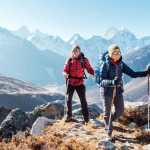Travelers who take trekking tours in Nepal experience more than natural beauty and physical challenge since they travel through different cultural groups throughout their adventure. The trekking areas distinctly present distinct cultural practices and linguistic and way of life customs that developed through mountain isolation and cultural adaptation over many generations.
Tourists who trek through Annapurna encounter Gurung culture, while Sherpa traditions are on display in Everest, besides Tamang heritage being experienced in Langtang Valley, thereby delivering comprehensive cultural understanding. Visitors find complete acceptance at these communities through traditional celebrations and welcoming traditions along with ancient customs that make trekking memories last forever.
Gurung Culture in the Annapurna Region
The Gurungs make up the largest ethnic community in the Annapurna region that includes important villages such as Ghandruk, Chhomrong, along with Landruk. The Gurungs relate to a people known for courage and they have earned their reputation as disciplined fighters while serving in both British and Indian Gurkha regiments.
Nature enthusiasts on Manaslu Circuit Trek or Ghorepani Poon Hill Trek trails will cross numerous Gurung villages where people maintain their traditional lifestyle by tending to crops and herding animals.
The attractive mountain views complement the traditional architecture and narrow pathways of Ghandruk village, which stands out as one of the most remarkable villages for experiencing Gurung culture. The Gurung Museum at this location displays their historical artifacts together with their weapons as well as traditional clothing and other belongings.
The local women choose to wear traditional clothing with eye-catching jewelry, during which visitors receive the chance to view or actively join cultural dance events organized during festival days. Gurung society has a distinct institution named Rodhi Ghar which serves as a village gathering space for musical and dance activities.
The people of the community gather during Dashain and Tihar festivals for animal sacrifices and receive decorative tika marks while participating in Deusi-Bhailo musical sessions. The Gurung observance of Lhosar as their New Year includes spectacular community celebrations through large feasts and racing horses together with masked performances.
The traditional food provided to tea house guests features home-cooked dal bhat and tongueba millet beer together with dairy products from the local region. Cultural experiences in Annapurna are enriched because of the welcoming Gurung people and their authentic customs which preserve their traditions.
Sherpa Traditions in the Everest Region
As an indigenous community of Nepal, the Sherpas gain worldwide fame due to their expertise in mountain climbing and their sacred bond with the Himalayan mountains. Sherpas originated from Tibet before establishing their settlements in the Khumbu region and constructing religious sites such as monasteries and chortens and prayer flags for trekking routes.
During Everest Base Camp Trek, travelers come across three Sherpa settlements, namely Namche Bazaar, Tengboche and Pangboche, which demonstrate the Tibetan Buddhist heritage of their community. The main market center in the Everest region, Namche Bazaar maintains its Tibetan house architecture and has numerous monasteries along with active marketplaces.
Visitors can explore the Sherpa Museum in this place that showcases their mountaineering accomplishments, besides their historical background. The Khumjung Monastery displays a Yeti scalp as part of its fame and makes the region more mysterious. Hikers find prayer wheels along the trails with mani stones imprinted Buddhist creeds that they should walk clockwise to honor.
Visiting Tengboche Monastery stands as the top cultural encounter within the entire Khumbu region. This religious center welcomes visitors for the Mani Rimdu Festival during which monks perform dances while conducting fire rituals and Buddhist chants. Local people along with trekkers join together at the festival to accept blessings and view dramatic performance shows.
Years of Sherpa tradition have earned them worldwide fame for their famous hostlike hospitality through the local tea houses, which serve butter tea, tsampa, roasted barley flour and dried yak cheese to tired travelers.
Buddhism has an evident impact on Sherpas because they practice a life of peace that opposes killing any living creature. The Everest cultural experience derives from Sherpa strength alongside their religious dedication and their welcoming spirit of hospitality.
Not only the cultural interaction with locals enrich the trekking experience, you can take the Everest Base Camp Helicopter Tour for a perfect trek ending which offers amazing views of the surrounding valleys and peaks.
Tamang Heritage in Langtang Valley
The Tamang maintains residential bases in the Langtang Valley and surrounding hill territories. From Tibetan horse trading ancestors came the Tamang population who preserve their Tibetan Buddhist heritage through their religious structures as well as their linguistic traditions and sacred celebrations. Their story follows a traditional lifestyle with the combination of the Tamang Heritage Trail together with the Langtang Valley Trek.
Traditional Tamang settlements exist in Syabrubesi together with Gatlang and Thuman where the houses are wooden and feature carved windows with Buddhist prayer flags placed strategically.
Since centuries monks at the Kyanjin Gompa monastery have continued to practice daily spiritual rituals and meditation at this important religious complex. Yak cheese enthusiasts can experience abandoned cheese factories operated by residents who prepare the cheese through their old methods.
During Sonam Lhosar, the Tamang people conduct prayer ceremonies while performing dances, while sharing meals in celebration of their New Year holiday. The Syabru dance stands out in Tamang cultural events because performers dance using traditional costumes while wearing eye-catching masks. The local population invites their guests to drink homemade yak butter tea and prepare chhyang (fermented rice beer) in their homes.
Healing rituals form an important element of Tamang culture through which shamans named dhami-jhankri practice their practices using chanting along with drums and herbal compounds to heal their patients. Villages throughout the route provide hot spring pools that people think possess healing capabilities for trekkers to recover after their hikes.
The Tamang people have a long historical background that suffered greatly from the 2015 earthquake, which trekking in Langtang aims to help reconstruct. Nature lovers will discover breathtaking views during trips to this attraction, alongside the chance to deeply experience traditional Tamang communities, which makes it an optimal cultural adventure through Nepal.
Lynn Martelli is an editor at Readability. She received her MFA in Creative Writing from Antioch University and has worked as an editor for over 10 years. Lynn has edited a wide variety of books, including fiction, non-fiction, memoirs, and more. In her free time, Lynn enjoys reading, writing, and spending time with her family and friends.















